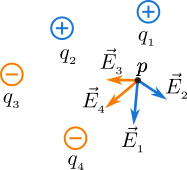Electric field is the electric force per unit charge. So the electric field produced by a fixed point charge \(q\) at a point \(p\) is the electric force per unit charge at that point \(p\). Now just consider that there is a positive point charge \(q_0\) at \(p\) at a distance \(r\) form charge \(q\). The electric force between the charges \(q\) and \(q_0\) is
\[F = k\frac{{q{q_0}}}{{{r^2}}}\]
The electric field \(E\) at the point \(p\) is the electric force given by above equation divided by the point charge \(q_0\).
\[E = k\frac{{q{q_0}}}{{{r^2}{q_0}}} = k\frac{q}{{{r^2}}} \tag{2} \label{2}\]
From the expression of the electric field you may notice that the electric field is independent of the charge \(q_0\). So, the electric field at the point \(p\) is always the same for any charge at that point. Electric field is a vector quantity and in vector form it can be expressed as,
\[\vec E = k\frac{q}{{{r^2}}}\hat r \tag{3} \label{3}\]
where \(\hat{r}\) is a unit vector along the line joining the charge and point \(p\). The unit vectors specify the direction in space- they point in a particular direction in space. The direction of electric field of a positive point charge is radially outward (or in the direction away from the charge) as shown in Figure 2(a) or Figure 3(a).


And the direction of electric field of a negative point charge is radially inward in the direction towards the charge as shown in Figure 2(b) or Figure 3(b). The direction of unit vector is in the same direction of electric filed of positive point charge but the direction of unit vector is opposite to the direction of electric field of negative point charge. The electric field can also be expressed in terms of electric field lines.


What is superposition of electric fields?
What happens to the electric field at a point when two or more point charges are present? Consider there are charges \(q_1\), \(q_2\), \(q_3\) and \(q_4\) distributed in a space and we need to find the electric field at a point \(p\) due to this charge distribution (see Figure 4).

The electric field at the point \(p\) is calculated by calculating the electric fields at that point by individual charges and the vector sum of those electric fields gives the net electric field (electric field due to the charge distribution) at that point. Note that you know from Eq. \eqref{2} that the electric field due to a point charge at the point \(p\) is independent of any charge present at that point. The total electric field at the point \(p\) due to the charge distribution is the vector sum of the electric fields due to individual charges. The electric field due to the charge \(q_1\) is \(\vec E_1\), the electric field due to the charge \(q_2\) is \(\vec E_2\) and so on. Therefore, the net electric field at the point \(p\) is
\[\vec E = {{\vec E}_1} + {{\vec E}_2} + {{\vec E}_3} + {{\vec E}_4} \tag{4} \label{4}\]
Also note that \(\vec F = q_0\vec E\) and if a charge \(q_0\) is present at the point \(p\), the total electric force at that point due to the charge distribution is
\[\begin{align*} \vec F &= {q_0}\vec E = {q_0}{{\vec E}_1} + {q_0}{{\vec E}_2} + {q_0}{{\vec E}_3} + {q_0}{{\vec E}_4}\\ \therefore \quad \vec F &= {{\vec F}_1} + {{\vec F}_2} + {{\vec F}_3} + {{\vec F}_4} \tag{5} \label{5} \end{align*}\]
Hence the total electric force at the point \(p\) on charge \(q_0\) is the vector sum of the electric forces due to individual charges which should be.





